Nikon Nikkor AF-S 200 mm f/2G ED VRII
3. Build quality and image stabilization
Despite his big dimensions, the Nikkor 2.0/200 VR II is a lens which, at a push, could be hung around your neck with a camera and taken out; you can still use it without a tripod or a monopod. When you attach a hood, however, the lens becomes much less handy.
The build quality of the Nikkor 2.0/200 is really exemplary - definitely worth an expensive lens aimed at professional photographers. Really it would be difficult to find any weak point in this category.
Please Support UsIf you enjoy our reviews and articles, and you want us to continue our work please, support our website by donating through PayPal. The funds are going to be used for paying our editorial team, renting servers, and equipping our testing studio; only that way we will be able to continue providing you interesting content for free. |
- - - - - - - - - - - - - - - - - - - - - - - - - - - - - - - - - - - - - - - - - - - - - - - -
In the photo below the tested lens is positioned next to the Nikkor 24-70 mm f/2.8 and the Sigma 1.4/30.
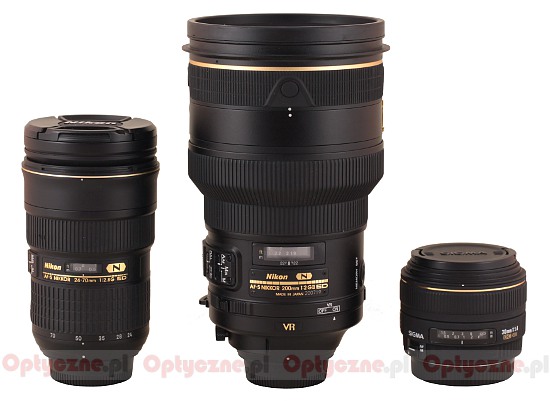 |
The lens starts with a metal bayonet mount with contacts. Inside the mount there is an immobile rear element of the lens, set at a depth of almost 3 centimeters. The inner tube near it is properly darkened and matted. Such a depth makes place for an extended rear filter which, in the case of the tested lens, is 52 mm in diameter. After inserting the filter the element is hidden at a depth of less than 2 centimeters.
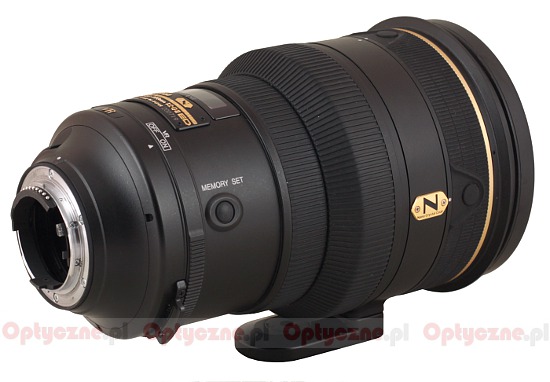 |
Moving onto the black and metal casing of the lens first we find a pocket for the filters, mentioned before and a round knob to take them out. Right behind it the body of the lens gets suddenly wider. At the very beginning we find metal fastenings to attach a strap which enables to carry the lens around. Right behind the fastenings there is a movable ring, 8 mm wide, which switches the optical stabilization on and off (VR OFF/ON).
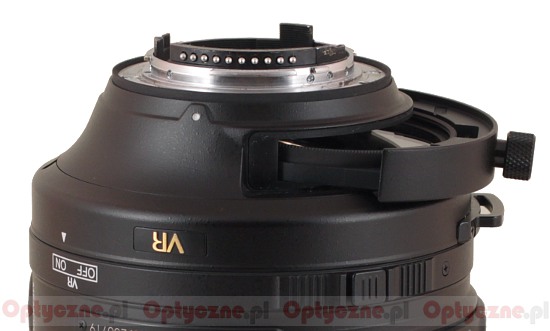 |
Then we meet a plate with the name and the parameters of the lens on which there is also a serial number and the info that the lens was produced in Japan. Over the plate there is a distance scale behind a window, expressed in feet and meters. Right below you see depth of field markings by f/22 aperture.
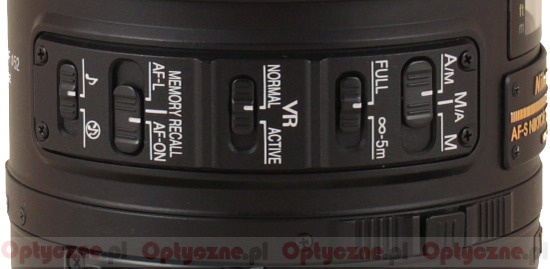 |
On the left side of the plate, looking from above, we get an impressive series of switches. The first one is used to choose the focusing mechanism mode. We have three modes available: M- completely manual, A/M – autofocus with a possibility of manual corrections but with the autofocus priority, M/A – autofocus with the possibility of manual corrections but with the manual priority. The second toggle sets the autofocus limit – there is the FULL range and a limited range from 5 meters to infinity. The third switch sets the image stabilization mode (VR NORMAL/ACTIVE).The next is used to set the mode of buttons positioned every 90 degrees at the front of the lens. We can choose between the modes: AF-L (AF Lock) which attributes the Focus Lock function, MEMORY RECALL, which reminds you the location of the remembered autofocus position and AF-ON which gives you the ability to activate the autofocus by the aforementioned buttons, positioned at the front of the lens. The last switch on this side gives you a possibility to turn on or off the sound while recalling the memorized autofocus position. Additionally, on the right side of the plate with parameters, there is one single MEMORY SET button. When you press it the device will remember the distance scale position so we can recall it later.
The next part of the lens consists of a manual focus ring as wide as 53 mm. Its construction is interesting indeed – in the middle its diameter (like the diameter of the whole body) increases from 9.7 to almost 12 cm. The ring is rubberized and ribbed and its work quality would be difficult to fault. Running through the whole distance scale takes a turn through 240 degrees.
Behind the manual focus ring you can find a smooth mobile ring with a solid tripod adapter. The producer decided it would be a great place to put a golden plate with a big N letter, meaning the usage of Nano Crystal Coat layers.
The next element is an immobile ring with a golden stripe, its considerable part being also covered by rubber ribs, which features buttons set every 90 degrees- their functions can be programmed by using the AF-L/MEMORY RECALL/AF-ON button we wrote about earlier.
Further on, we get a hood thread which is used to attach a lens hood; along with a fabric cover, it creates a cap for the huge front element. The front element is immobile, 107 mm in diameter, and hidden inside the case at the depth of one centimeter.
When it comes to the internal construction we deal here with 13 elements positioned in 9 groups. As many as four of them are made of low-dispersion glass, including three made of ED and one – of Super ED glass. On a diagram you can notice that 13 elements of the optical construction are supplemented by two flat protective elements as well. The first is a flat element protecting the huge front lens and the last one is the filter, mentioned before (it can be removed). Although they don’t take part in the main optics work their existence in the whole system makes the transmission lower slightly on the additional air-to-glass surfaces. Inside the lens there is also a circular aperture with nine diaphragm blades which can be closed down to f/22.
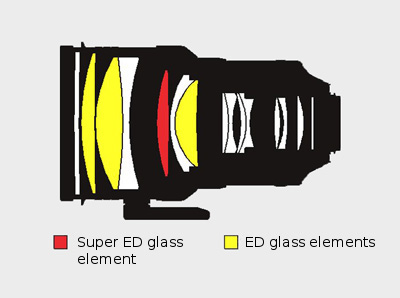
The accessory kit also includes: a rear plastic cap, a huge hood which, along with the cover designed for it, serves as the front cap, a build-in tripod adapter, a removable Neutral Color NC filter, 52 mm in diameter, a strap and a case.
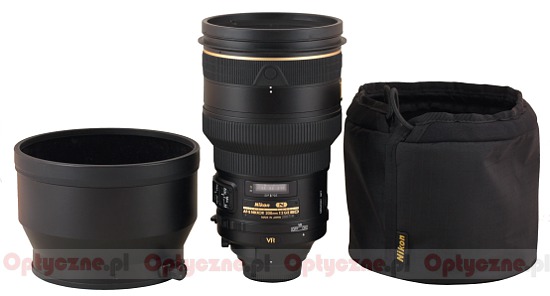 |
Image stabilization
Currently almost all producers boast of optical stabilization as efficient as 4 EV in their lenses. The problem is that, in reality, such a good stabilization is offered only by the best and the most expensive lenses on the market; in most cases the efficiency of the stabilization mechanism reaches only 2-3 EV. How the tested Nikkor 2/200 VR II fares can be seen on a graph, published below.
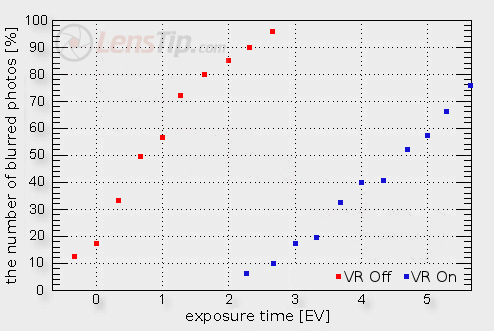
It shows the percentage of blurred photos as a function of the exposure time expressed in EV, where 0 EV is the equivalent of 1/200 of a second. That percentage includes photos taken with the stabilization switched on and off. The stabilization efficiency we determine by measuring the maximum distance between both curves. In this case it reaches exactly 4 EV so the stabilization is as efficient as the producer declares. At the same time it is a very good result, worth of an expensive, professional lens.






